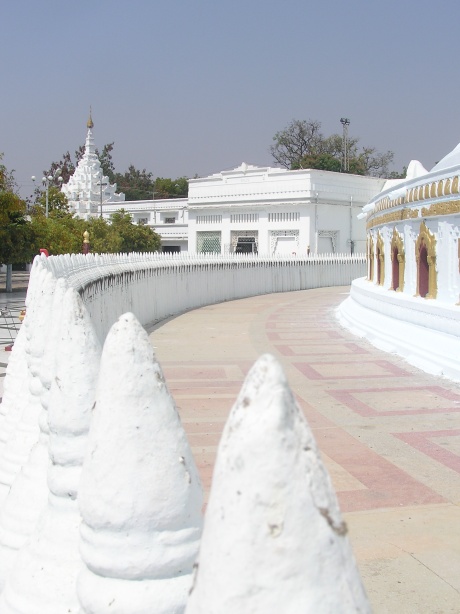|
The
Kaunghmudaw Pagoda is one
of the most iconic and revered Buddhist sites in
Myanmar. It is located
near the town of Sagaing,
approximately 20 kilometers to the west of
Mandalay, in central
Myanmar. The pagoda is notable for its striking,
large dome-shaped stupa
that resembles a giant, golden
bell.
Key Features of the Kaunghmudaw
Pagoda:
-
Architectural Style:
- The Kaunghmudaw Pagoda
features a large,
spherical dome, one of the most distinctive features of
its design. The stupa’s golden surface reflects the sunlight,
making it a dazzling sight from a distance.
- The pagoda is encircled by a
series of smaller stupas, creating a serene and peaceful
environment for reflection and worship.
-
History and Origin:
- The Kaunghmudaw Pagoda was
constructed in 1636
during the reign of King
Thalun of the
Ava Kingdom. It was built to commemorate the
relics of the Buddha,
which were enshrined within the stupa.
- According to legend, King
Thalun wanted to build a pagoda that could match the grandeur of
the Shwedagon Pagoda
in Yangon,
and thus the Kaunghmudaw Pagoda was designed to be similar in
size and shape to that of the great Shwedagon.
- Over time, the pagoda
underwent some repairs and restoration, but its
basic architectural
form has remained consistent since its original
construction.
-
Size and Significance:
- The Kaunghmudaw Pagoda has
a height of about 46
meters (151 feet), making it one of the largest pagodas
in Myanmar.
- The golden dome is the
central point of attraction, and its grandeur symbolizes the
infinite nature of the universe in Buddhist cosmology.
- Like many other pagodas in
Myanmar, Kaunghmudaw Pagoda is believed to hold
relics of the Buddha,
making it a site of immense spiritual significance for
Buddhists.
-
Religious Importance:
- The pagoda is a major
pilgrimage site for local and international Buddhists who visit
to pay their respects and make offerings.
- As with other sacred sites
in Myanmar, the Kaunghmudaw Pagoda is a place for
meditation
and devotional
activities, and visitors often see monks and laypeople
practicing Buddhist rituals, such as lighting incense and
offering flowers and candles.
-
Peaceful Surroundings:
- The pagoda is located on a
hill, providing visitors with beautiful views of the surrounding
Sagaing Hills
and the Ayeyarwady
River. The area is known for its tranquility and serene
atmosphere, making it a perfect place for reflection and prayer.
- It is also surrounded by
numerous other smaller pagodas and monasteries, as Sagaing is
one of Myanmar's most important centers of
Buddhist monastic life.
The area is dotted with
monasteries,
where monks devote themselves to study, meditation, and
teaching.
Visiting Kaunghmudaw Pagoda:
-
Accessibility:
The Kaunghmudaw Pagoda is easily accessible from
Mandalay by car
or motorcycle. Many visitors also combine a trip to this pagoda with
a visit to other nearby attractions in the
Sagaing region,
such as Umin Thonzeh
and Sagiang Hill.
-
Best Time to Visit:
The best time to visit is during the early morning or late afternoon
when the light is soft, and the pagoda's golden dome shines
brightly. It is also less crowded during these times, making it more
peaceful for meditation and reflection.
-
Dress Code: As
with all Buddhist sites in Myanmar, visitors should dress modestly,
covering their shoulders and knees when visiting the pagoda. It’s
also customary to remove your shoes before entering the temple area.
Conclusion:
The Kaunghmudaw Pagoda
is a remarkable and significant Buddhist monument in Myanmar, offering a
glimpse into the rich cultural and spiritual heritage of the country.
Its grandeur and peaceful setting make it a must-visit for anyone
traveling to central Myanmar, especially those interested in Buddhist
history and architecture. The pagoda’s historical background, striking
appearance, and spiritual importance make it a fitting representation of
Myanmar's deep devotion to
Buddhism.
The Kaunghmudaw Pagoda (also
spelled Kaunghmudaw) is a
significant Buddhist pagoda located near Sagaing,
in central Myanmar. It is renowned for its unique
architectural style and historical importance. Here’s an
overview of this fascinating site:
Key Features of Kaunghmudaw Pagoda
-
Architecture:
-
The pagoda is built in the Sinhalese
style, resembling a giant egg or a bell,
which is unusual compared to the traditional Burmese
pagoda design.
-
It stands 46 meters (151 feet) tall
and has a circumference of 274
meters (899 feet) at its base.
-
The structure is whitewashed, giving it a striking
and serene appearance.
-
History:
-
The pagoda was built in 1636 by
King Thalun, the
founder of the Nyaungyan Dynasty, to commemorate the
re-establishment of Ava (Inwa) as the capital of
Myanmar.
-
It is said to enshrine sacred relics of the Buddha,
making it an important pilgrimage site.
-
Religious Significance:
-
Surroundings:
-
The pagoda is surrounded by a large, peaceful
complex with smaller stupas, shrines, and statues.
-
The area is lush and green, offering a tranquil
atmosphere for visitors.
Visiting Kaunghmudaw Pagoda
-
Location: The pagoda is located about 10
kilometers (6 miles) from Sagaing,
which is easily accessible from Mandalay (approximately
20 kilometers or 12 miles away).
-
Best Time to Visit: Early morning or
late afternoon is ideal to avoid the heat and enjoy the
serene ambiance.
-
Etiquette: As with all Buddhist sites
in Myanmar, visitors should dress modestly and remove
their shoes before entering the pagoda.
Interesting Facts
-
The pagoda is sometimes referred to as the "Yaza
Mani Sula Kaunghmudaw", meaning "the pagoda
that grants wishes."
-
Its design is said to have been inspired by the Ruwanwelisaya
Stupa in Sri Lanka, reflecting the
strong cultural and religious ties between Myanmar and
Sri Lanka.
Kaunghmudaw Pagoda is a must-visit for those interested in
Myanmar's rich Buddhist heritage and unique architecture.
Its peaceful setting and historical significance make it a
memorable stop on any journey through the Sagaing region.
|
|
 Safaris
Bergsteigen
Wandern
Inselwandern Weltweit
Safaris
Bergsteigen
Wandern
Inselwandern Weltweit
 Europa
Inselwandern
Europa
Inselwandern
 Städtewandern
Städtewandern
 Paintings
Paintings Dirk Rauschenbach
Dirk Rauschenbach
 Safaris
Bergsteigen
Wandern
Inselwandern Weltweit
Safaris
Bergsteigen
Wandern
Inselwandern Weltweit
 Europa
Inselwandern
Europa
Inselwandern
 Städtewandern
Städtewandern
 Paintings
Paintings Dirk Rauschenbach
Dirk Rauschenbach

![]() 26.07.25 Copyright Dirk
Rauschenbach Koelnerstrasse 293 51702 Bergneustadt
Datenschutzerklaerung 02261 9788972 Mail ccooly(
at) web.de
26.07.25 Copyright Dirk
Rauschenbach Koelnerstrasse 293 51702 Bergneustadt
Datenschutzerklaerung 02261 9788972 Mail ccooly(
at) web.de